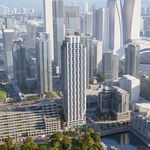It runs on the road, not on its own corridor segregated from all other vehicles. VIVA rapid ways are not rapid transit by the general definition of rail rapid transit, rather is just BRT. The nomenclature breaks down at this point so it's pointless arguing about it.
Personal Opinion: they just call it "Bus Rapid Transit" because they're too cheap to build rail, and it gives the public a sense of value-for-money (which most systems are, but the vast majority are names and nothing more) when in most cases, it's just improved bus service. Very few (Mississauga transit-way for the most part, OC Transpo's Rapidways) are actually at the level of rapid transit. Most (MTA Select Bus Service, iON BRT, iXpress (2XX GRT), HSR's proposed lines, Rockets (9XX TTC), Züm (5XX Brampton), VIVA (for the majority of it), etc) are just cheaply-executed bus improvements rather than actual rapid bus service, which costs significantly more.




